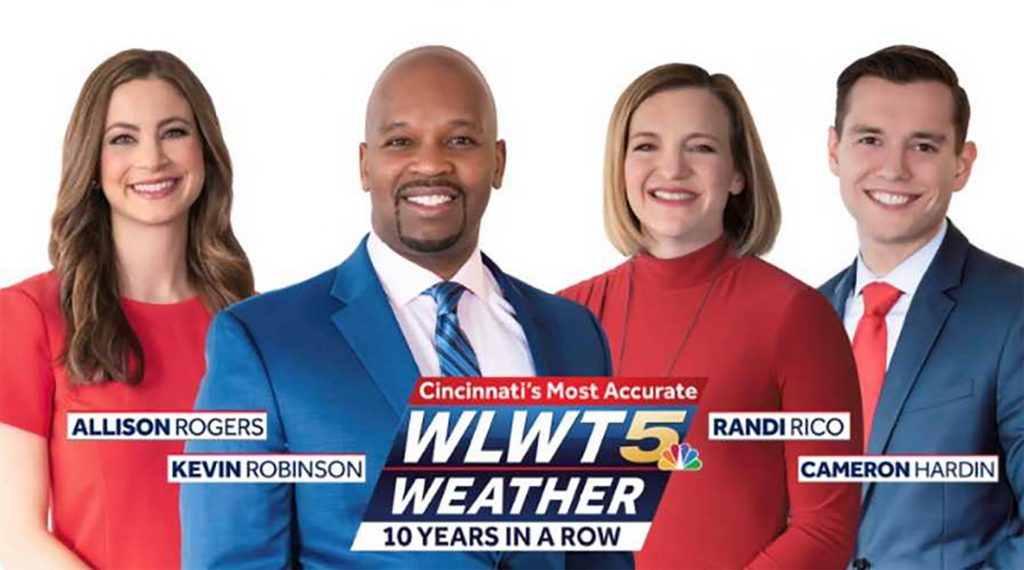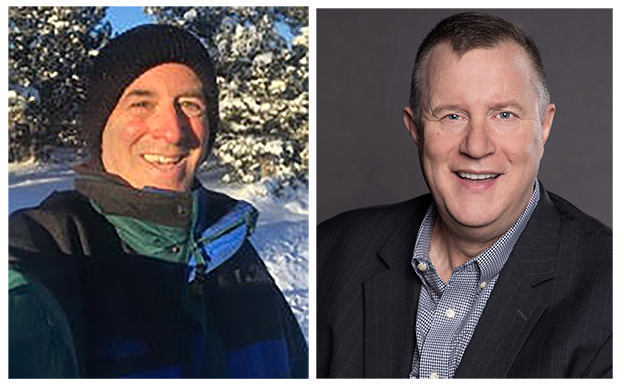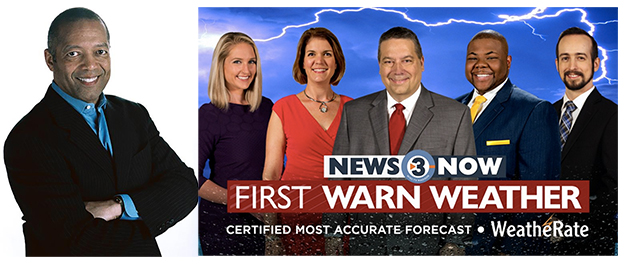
EDITOR’S NOTE: This story is part of Changing Weather, our occasional series on innovation in local weather coverage. Check out earlier installments here.
Kevin Robinson waits eagerly for the announcement each spring.
Sure, he’s gotten the same good news for the past 10 years. But it never gets old — and it’s never guaranteed.
“The excitement never goes away,” says Robinson, chief meteorologist at Hearst-owned WLWT in Cincinnati. “It’s hard staying in first place. It’s like winning the championship. It’s like winning the Super Bowl of weather forecasting.”
This year, WLWT’s weather team beat out three rival stations to earn its tenth consecutive “Super Bowl” title — actually known as the seal of approval from WeatheRate, an independent research company that evaluates the forecasts of local TV stations across the country’s 95 largest markets and certifies one as the most accurate in each community.
The idea came to Bruce Fixman — WeatheRate’s founder and president, and a meteorologist himself — about 20 years ago.
“I was tired of every TV station claiming to be the most accurate, wherever I went,” says Fixman, whose six-employee company is based in Phoenix. “Every city, you’d go to turn on the TV: ‘We’re the most accurate.’ ‘We’re pinpoint.’ ‘We’re the most accurate.’ It’s like, ‘This is ridiculous. I want to know who it really is.’”

Inspired by his college days competing in forecasting contests against other schools, Fixman designed a methodology and launched his business. Every day, his staff gathers stations’ forecasts in a database, investigates how they stack up against actual conditions using data from the National Weather Service and National Oceanic and Atmospheric Administration, and then uses a proprietary scoring algorithm to rate their accuracy.
“It’s pretty detailed,” says Fixman. “We’re looking at sky cover, precipitation, timing of precipitation, strong winds, dense fog, severe thunderstorms, and in places where it snows, snow and ice accumulation. So it’s pretty exhaustive. When I went into this, I was like, ‘Okay, I’m not going to do just high and low temperatures. That’s like a middle school project.’”
Also unlike a middle school project? There’s no prize for second place.
Stations don’t pay to be evaluated, but at the end of WeatheRate’s yearlong research period, the station with the best cumulative score in its market can pay to license the company’s “most accurate” branding for the next year. “If number one says ‘no,’ we’re not going to go to number two and say, ‘Number one doesn’t want it. Do you want it?’ We don’t do that,” says Fixman.
How much does it cost to license WeatheRate’s seal? “We keep that private,” he says. “But I will tell you this . . . the ROI is off-the-charts. We’re not that expensive. We’re a lot less expensive than a new Doppler radar the TV station might buy or even a weather graphics package that they may buy. We’re not even in the same universe as those.”
The fact that you can’t buy the title — or luck into it — is what makes it so coveted, says WLWT creative services director Pete Salkowski. He remembers there was a “big brouhaha” when the station first earned the achievement in 2011, breaking a crosstown competitor’s years-long streak: “It took a lot of dedication, hard work, and accurate forecasting to take it away from them.”
Watch this spot promoting WLWT’s “most accurate” certification. It aired after the station earned its sixth straight title. (Courtesy of WLWT)
Since then, WLWT has used broadcast spots, digital banners, and more to highlight the recognition. Salkowski says it’s helped to communicate the weather team’s scientific expertise, local knowledge, and reliability — three hugely important traits in an era when competition is increasing, public trust in the media is waning, and unproven claims can easily gain traction.
“You can say whatever you want,” he says. “You can source anything: ‘We have the best news in town, according to my mom.’ ‘We asked 10 people on the street, and they all love us.’ But we’re not saying we’re most accurate. WeatheRate is saying we’re most accurate — and that’s the difference. It’s an independent company. They verify it. They certify it. They’ve got the science behind it.”

Over the last decade, Salkowski says that message has “resonated really well with the people in Cincinnati,” citing both ratings and the station’s own research.
“At the time we got it, we were probably, honestly, trending around three or four in the market,” he says. “Now, we’re one or two — consistently one or two. So there’s a trust between the viewers and the people who they see. They trust them to keep them safe during severe weather, to prepare them for the day with an accurate forecast. It’s a great achievement for our meteorologists.”
It’s also a major accomplishment for WISC-TV in Madison, which just earned its first WeatheRate certification this year. Lyle Banks — VP and general manager of the Morgan Murphy Media-owned station — sees it as an critical tool for the future.
“I have decades of experience in TV management, and there’s always a commonality with stations that are either number one or on their way to number one: how well the market perceives their weather operation,” says Banks. “It’s virtually impossible to have a number-one station without having a number-one weather operation. And for us, getting that designation is a big step to continuing to move the station forward.”

Beyond building community trust or external marketing power, he says earning the “most accurate” title also means a lot internally. Weather teams can see their market’s accuracy rankings — or get their hands on WeatheRate’s data — whenever they like, opening the door for real-time self-evaluation and improvement.
“To be able to do that really requires a lot of communication among our meteorological team,” says Banks. “They have to collaborate and be in sync in so many different ways, so it really promotes a sense of teamwork — this designation or the quest for this designation. It’s like having a golf team, where if one member of the team scores a bogey, that affects the entire team score.”
“It’s a way to keep us accountable,” agrees WLWT’s Robinson. “Throughout the season, we’re able to gauge where we are in this four-man race: Are we really smoking them? Or do we need to work even harder? So it’s good to be able to have an independent source, where everyone is on the same playing field, and you have the opportunity to outshine your competition.”
More stations may have that opportunity in the years to come. WeatheRate has expanded its research into the country’s 25 largest Spanish-language markets in the last three years, and Fixman says he may continue to add markets in the U.S. — or even branch out into Canada. He’s also drilling down further into areas with particularly complex weather.
For example, “San Francisco at the coast is different from San Francisco Bay, which is different from inland another five miles,” says Fixman. “So we’ve started splitting forecasts into those microclimates, and we’ll verify for those three different microclimates. In San Diego, we do two: We do coast and valleys. And we’ll probably start doing coast and valleys in LA soon, too. We just haven’t gotten there yet.”
Whatever happens next with Fixman’s company — or in the broader world of weather innovation — Robinson says there’s one thing that won’t change: “Everyone claims that they are the best, or everyone has the super-duper Doppler that can see from here to Japan. And it’s like, ‘No, what can you do for viewers locally? What’s the information they need? Can they trust you — and is it accurate?”
“At the end of the day, a lot of people just want to know: ‘How is this going to impact my life? How is it going to impact me picking up the kids from the bus stop? How is it going to impact scrimmage after school?’ So for us, it’s just an easy way to be able to say, ‘Hey, over here! You don’t have to go any further. Stop right here.’”
If you know a meteorologist or weather innovation that deserves to be featured in our ongoing series, please send us an email at cronkitenewslab@asu.edu.
Get the Lab Report: The most important stories delivered to your inbox